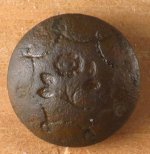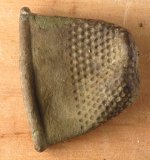rhedden
Sr. Member
Today started off with questionable weather, with an approaching line of thunderstorms that threatened to soak me mid-morning. Deciding to hike out onto the mountain more than an hour from my vehicle was questionable, but I'm glad I did. The rain never materialized, and I had a Bucket Lister type of hunt.
The object of today's expedition was a cellar hole that does not appear on an early 1860s map, but shows up in a mid-1870s map. I mostly target cellar holes from the early 1800s or before, so this one had lower priority for a summer expedition.
I hiked out there thinking I could find it on Google Maps using my phone based on its position relative to a creek, but the terrain was just brutal. I felt like I needed a hired Sherpa just to get me around the side of the mountain. The area was a tangled mass of old forest roads and newer logging roads with plenty of knee-high ferns to help hide the evidence of any cellars. Some logging crews had recently been in there and made a mess out of it too. After going steeply downhill into a ravine, thinking I'd pay for that decision later, I got lucky and walked right up to the site.
This cellar hole was the above-ground type, not the type sunken into the ground with neatly inlaid stones in the walls. It was a one-room cabin clinging to the steep side of the mountain with no stone walls around it and no improved land for farming nearby. The assumption is that someone poor lived up there, or perhaps it was someone infected with TB who decided to leave the village (which I think was commonplace in the 19th century New England).
The front side of the house faced uphill. It was obvious from the flat, cleared area on that side of the house, and the circular "driveway" going around both sides. I turned on my machine, took a couple of swings, and got a lovely "Obvious Lincoln Cent" signal right by where the front steps would have been. The signal was +68/69 on the Simplex+, repeatable, and not more than 1 inch deep. Thinking it was a modern penny dropped by a logging crew or hiker, I popped it up without so much thinking of silver. I was so surprised when I saw the thin edge of a well-worn silver coin looking back at me! Could it be my first half dime? Given the 1860s-1870s construction of the house, a half dime or trime makes sense, but... how about a holed 1781 silver Half Real instead?
I never imagined I'd find my first Spanish Silver at a post-Civil War site on the side of a mountain. Well, here it is, along with a very small button with flower design (Rich Color backmark) and a squashed thimble found later in the hunt. I'm still speechless after hunting many earlier sites that could have given me my first Real over the past 25 years, but this little, isolated cabin site was the magic bullet.
Hope y'all enjoyed the story and the photos. Now if anyone has a cure for leg cramps, I'd like to know, considering it took me 1 hour and 15 minutes to walk back up the steep hill to my car after the hunt.


The object of today's expedition was a cellar hole that does not appear on an early 1860s map, but shows up in a mid-1870s map. I mostly target cellar holes from the early 1800s or before, so this one had lower priority for a summer expedition.
I hiked out there thinking I could find it on Google Maps using my phone based on its position relative to a creek, but the terrain was just brutal. I felt like I needed a hired Sherpa just to get me around the side of the mountain. The area was a tangled mass of old forest roads and newer logging roads with plenty of knee-high ferns to help hide the evidence of any cellars. Some logging crews had recently been in there and made a mess out of it too. After going steeply downhill into a ravine, thinking I'd pay for that decision later, I got lucky and walked right up to the site.
This cellar hole was the above-ground type, not the type sunken into the ground with neatly inlaid stones in the walls. It was a one-room cabin clinging to the steep side of the mountain with no stone walls around it and no improved land for farming nearby. The assumption is that someone poor lived up there, or perhaps it was someone infected with TB who decided to leave the village (which I think was commonplace in the 19th century New England).
The front side of the house faced uphill. It was obvious from the flat, cleared area on that side of the house, and the circular "driveway" going around both sides. I turned on my machine, took a couple of swings, and got a lovely "Obvious Lincoln Cent" signal right by where the front steps would have been. The signal was +68/69 on the Simplex+, repeatable, and not more than 1 inch deep. Thinking it was a modern penny dropped by a logging crew or hiker, I popped it up without so much thinking of silver. I was so surprised when I saw the thin edge of a well-worn silver coin looking back at me! Could it be my first half dime? Given the 1860s-1870s construction of the house, a half dime or trime makes sense, but... how about a holed 1781 silver Half Real instead?
I never imagined I'd find my first Spanish Silver at a post-Civil War site on the side of a mountain. Well, here it is, along with a very small button with flower design (Rich Color backmark) and a squashed thimble found later in the hunt. I'm still speechless after hunting many earlier sites that could have given me my first Real over the past 25 years, but this little, isolated cabin site was the magic bullet.
Hope y'all enjoyed the story and the photos. Now if anyone has a cure for leg cramps, I'd like to know, considering it took me 1 hour and 15 minutes to walk back up the steep hill to my car after the hunt.
Attachments
Last edited:
Upvote
40





 Congrats!
Congrats!

